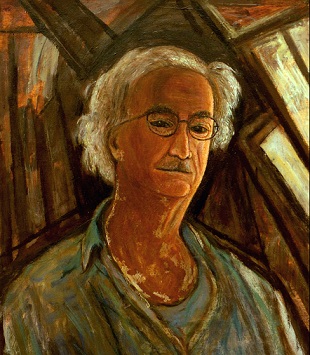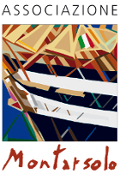
Carlo Montarsolo was born in Marmore (Terni) on May 29th, 1922. After a few years his family moved to Portici (Naples) where he studied and achieved a degree in Economics at the University “Federico II” of Naples.
When he was 15 he won the prize “Arts’ Ludi Yuvenilis” with a series of ink-drawings inspired by the “4th Book of Laudi” of Gabriele D’Annunzio.
At 16 he felt a strong inner love for oil-colours and brushes and nearly every day he walked up the Vesuvio together with Placido, another local painter. Or to the port of Granatello to practice a “plain-air” painting and the “right cut” for his works, following the Crisconio’s school. During one of these sessions in the open-air he discovered the secret for a new way of mixing colours: in fact due to a sudden storm, the rain fallen on his palette made him understand how to realize a new personal mixture which he always used eversince.
At 19 he enlisted for his Military Service as an Officer in the Infantry at first and later in the Aeronautics. But during these years he never gave up painting. In fact many of his works of the period 1946-1950 are still in possession of different Military Boards. In 1961 the Aeronautical Academy of Pozzuoli acquired his large oil painting “Einstein”.
In 1948 he held his first important personal exhibition at the “Galleria Forti” in Naples for which the well known critics Barbieri, Schettini, Girace enthusiastically wrote about.
In 1957 Montarsolo wan the “Mancini Prize” sponsored by “Fine Arts Academy” of Naples and he was the only “external” artist to obtain such a recognition.
In 1958, together with Birolli, Santomaso, Cassinari and other well known artists, he was invited to participate with three oil paintings to the “Marzotto Prize”.
At this time of life Carlo Montarsolo felt the urge to find new horizons and to feel the “European breath”. He therefore left for Belgium where, at Knokke sur la Mer, visited two important exhibitions of Picasso and Braque by which works he was struck. He also studied other new European trends.
When coming back to Portici he had deeply absorbed the basic lesson of the “analytic cubism” and started to produce new works between reality and abstraction which were the result of a long suffered personal training that lasted some years (1951-1971). Dated from these years are his most beautiful geometrical abstract compositions which culminated in important oils like “Einstein” (the first of a series of signatures captured and expressed with shapes and colurs like Mozart, Brahms, Beethoven, Bach and Leopardi). Of the same period his “The submerged temple”, a large oil work inspired by Debussy’s “Cathedrale engloutié”, which represented the first authentic example of analytic cubism seen in Naples. At “Mostra del Mezzogiorno” in the Royal Palace of Naples this painting obtained in 1962 the biggest recognition from a jury presided by Giulio Carlo Argan and composed by well known art critics as Francesco Arcangeli, Cesare Brandi, Palma Bucarelli, Luigi Carluccio, Franco Russoli, Marco Valsecchi and Raffaello Causa.
After that, during the period 1968-1974, he participated to almost all the national competitions winning many of them and obtaining, amongst others, the First Prize for Sacred Art of the “Antoniano’s Institute” in Bologna (1969). In 1970 he wan also the First Prize at Villa S. Giovanni important competition.
He was always present with his works at every Quadriennale in Rome, Biennale in Venice and later in Melbourne, New York and Sydney as a representative of Italian Painters recommended by the Quadriennale of Rome.
As from 1975 Carlo Montarsolo was invited by many Italian Institutes of Culture in South and North America to operate his brilliant artistic and cultural activity holding conferences and seminars and exhibiting his most recent paintings. With the help and sponsorship of the respective Italian Embassies, he repeated the same experience in many European cties as Stockholm, Helsinki, Turku, Munich and Amsterdam.
When returning to his studio of Portici (an old Borbonic loft located between the Vesuvio and the sea) he went back to the subject of the “sea” inspired by E. Montale’s poem “Ossi di seppia”. At the end of 1980 Raffaele Causa “Sovraintendente Beni Culturali e Artistici” of Naples, recommended his works to be exhibited in a personal antological exhibition at “Villa Pignatelli” Museum In Naples which was held in 1986: a well deserved compensation for the results he had obtained both in national and international fields.
For his artistic and cultural merits he was conferred by the Head of State with the Republic Commendation.
In 1993 he held another personal exhibition “Images of Creation and Geometry of Forms” at the University “Federico II” of Naples where as a student he had obtained his degree. In 1996 some other exhibitions took place in Rome and during the same year he received in Gela (Sicily) the prestigious prize “Sileno d’Oro” for his career which had been awarded in preceeding years by F. Pirandello and R. Guttuso. During his whole life he contributed to Art as a writer with articles in newspapers and magazines like “30 Giorni” directed by Giulio Andreotti. In 2002 his book “An artist narrating art” was published.
From 2003 onwards he went on holding lectures, seminars and conferences especially to young people and students. The last oil paintings represent “Amerigo Vespucci”, the Italian sailing military ship.
The life of Carlo Montarsolo, Artist and lover of Art, ended in Rome on July 23rd, 2005.
In 2014 his son Federico started to promote his father’s works organizing various exhibitions in Italian and foreign Museums in Montenegro, Switzerland, Armenia, with the support of the Italian Ministry of Foreign Affairs.
